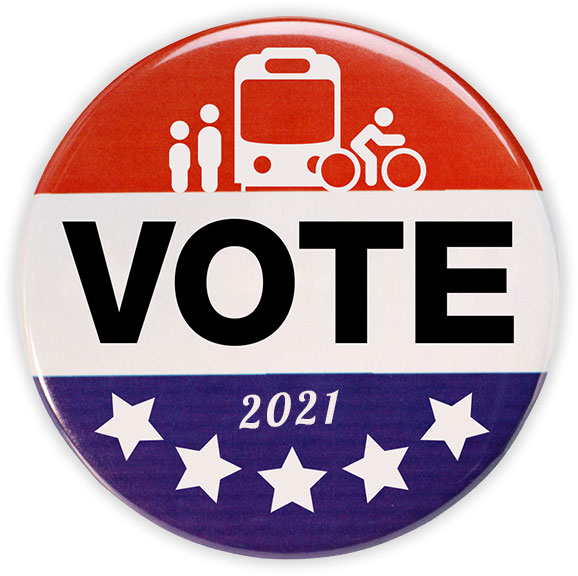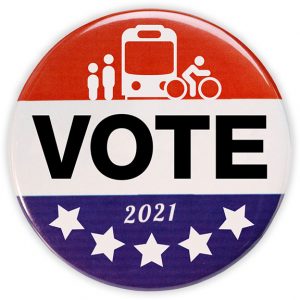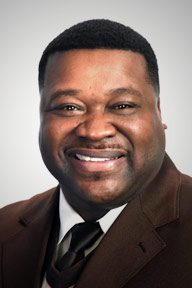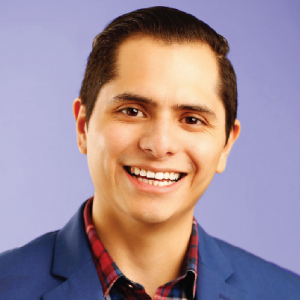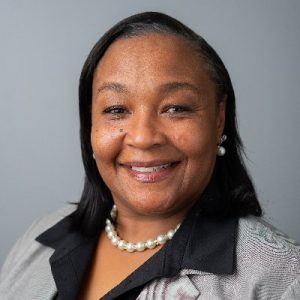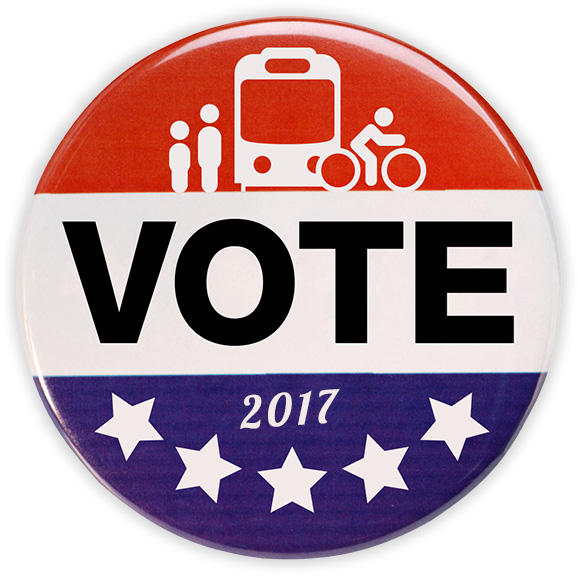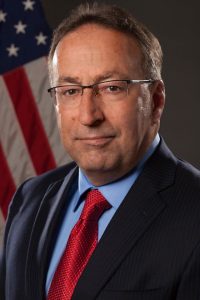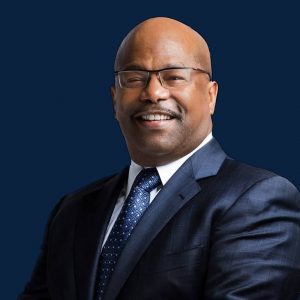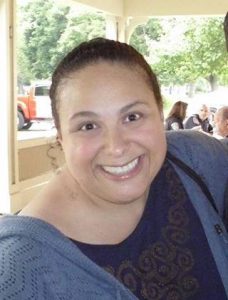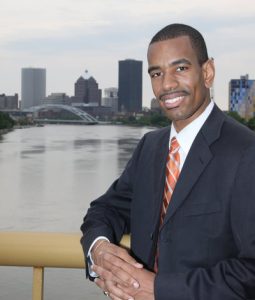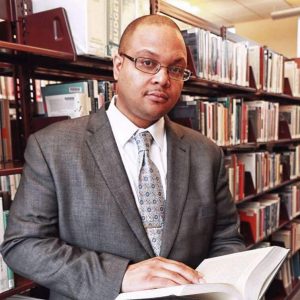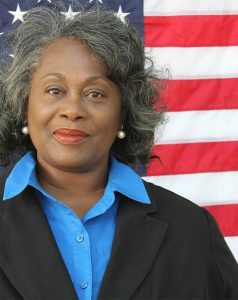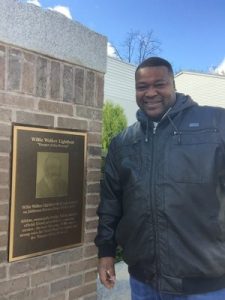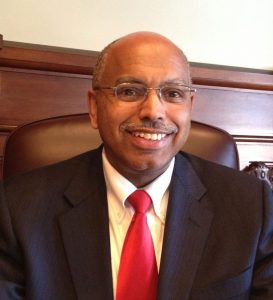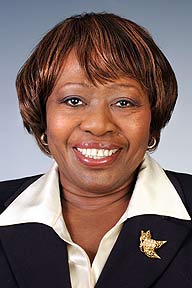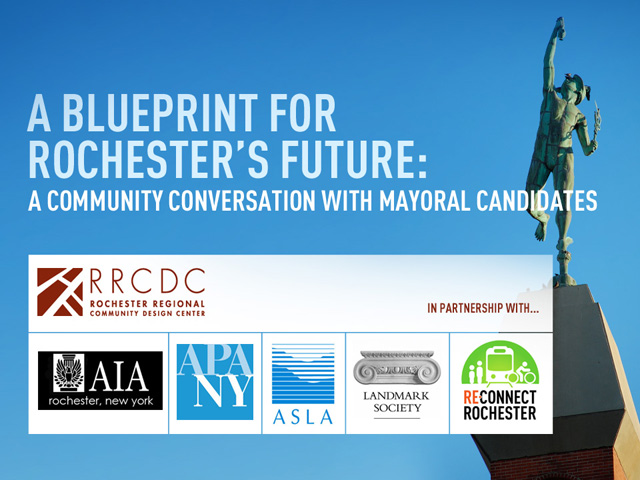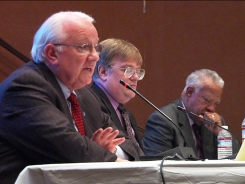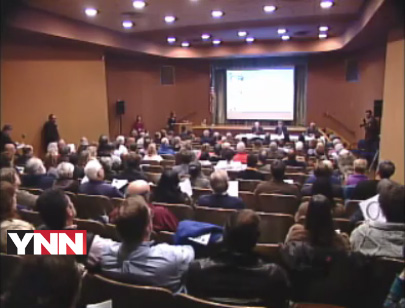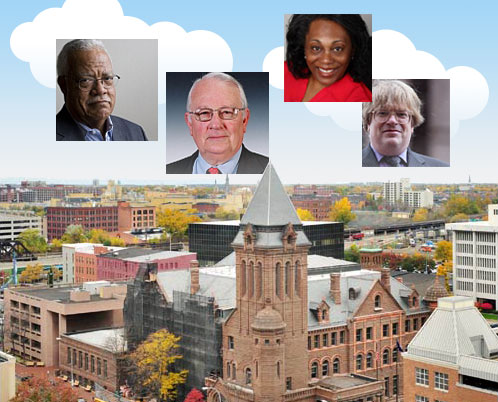*NOTE: This list includes all candidates on the ballot for the June 22nd Primary.
In April, Reconnect Rochester surveyed all Primary candidates for Rochester Mayor and City Council to learn where they stand on issues related to transportation and mobility.
Questions were designed to give the candidates the opportunity to share their opinions, ideas and vision for a well-connected and accessible community. We hope this information will help you make an informed decision when you head to the polls on June 22 and November 2. We did our best to make contact with all of the candidates.
Click on the candidate names below to read their full, unedited responses. Candidates are listed in alphabetical order.
Candidates for Mayor:
Malik Evans
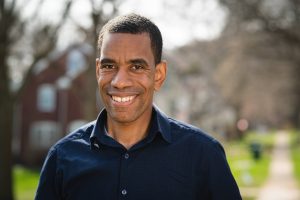 Candidate Email: malik@malikevans.org
Candidate Email: malik@malikevans.org
Website: www.MalikEvans.org
What are Rochester’s greatest transportation challenges?
Lack of reliable transportation for city residents to get all over Monroe County in a timely and efficient manner.
What are the top benefits our community would see by getting residents out of their cars and experiencing other modes of travel?
We would cut down on air pollution, greater physical health benefits can be gained by biking and walking.
What do you think City government can do to support public transit and create more equitable transportation options, especially in communities of color?
We need a real ride share program that targets minority communities that go beyond the pilot stage. We should also explore transportation options that service all corners of the county. Residents should have choices on where they want to work or live and transportation should not be a barrier.
What steps can the City take to improve accessibility to jobs for the 26% of Rochester residents who do not own or have access to a personal vehicle?
First off we need more businesses to locate in neighborhoods so that people can bike or walk to work if they choose. Secondly we must ensure that mass transit is efficient and widely available so that people can get to where jobs are.
What steps will you take to encourage/incentivize residents (especially City employees) to commute using transportation options other than single occupant vehicles (walk/bike/bus/carpool/etc.)?
I am a big fan of promoting walking. I usually walk to most of my appointments when I am in the downtown area. I would encourage carpooling and we must spread public awareness about biking and safety. It is still way too dangerous for many bicyclist and often pedestrians and that must change.
How will you lead the community in reducing our transportation carbon footprint? Do you or would you be willing to take the bus, bike or walk to City Hall?
I would love to be able to walk to city hall or to meetings from city hall. I would also like to take public transit from time to time to demonstrate the importance of mass transit.
How specifically will you support the transportation vision outlined in Rochester 2034?
I would advocate for Rochesters share of infrastructure funding so that we could have a diverse range of transportation choices for walking, biking and public transportation. Also ensure land use and and transportation regulations are integrated. This can only be done by engaging all sectors of the community. I would make public engagement on transportation and infrastructure a centerpiece of my administration.
What land use and economic development policies would you pursue to encourage job creation and development to remain in the city core, and better connect people in the city to employment opportunities?
We would encourage and incentivize small and medium size businesses to locate in neighborhoods. A person should not have to travel long commutes for work. I have always had short commutes and this has allowed me to use that time constructively.
Are you satisfied with our current sidewalk and bus stop snow removal policies? What opportunities for improvement do you see?
We can always improve on ensuring there is adequate clearing for snow removal around bus stops and frequently traveled walking areas. I see an opportunity to engage the public with getting involved in highlighting the needs and possibly adopting a sidewalk.
Do you support a “Vision Zero” style approach to road safety, which includes lowered speed limits and other traffic calming practices and policies?
Absolutely. I am very distressed by the lack of care on streets across this country. We regularly see people travelling above 40mph on streets across the city.
What specific actions do you suggest to make Rochester safer for pedestrians and bicyclists of all ages and abilities?
Speed Bumps, lowered speed limits, and regular public awareness activities. I am still shocked by the lack of respect shown to bicyclist and pedestrians. We must work together collectively to change it.
Would you favor the establishment of a bike/pedestrian advisory committee with the power to review road projects and make recommendations?
Yes.
Rochester recently received a renewal of its “Bronze” level award as a bike-friendly community. One of the key steps to receiving “Silver” status is a dedicated budget for implementing our Bike Master Plan. Would you support a line item in the budget devoted to bike infrastructure?
Yes and if we work with are partners at every level of Government state and federal we can reach silver.
Are there any other comments or thoughts you’d like to share about transportation and mobility in Rochester?
We can do better, we need high speed rail and easier transportation options. We should be able to get around without needing access to a car. I believe we can get there.
Mayor Lovely Warren
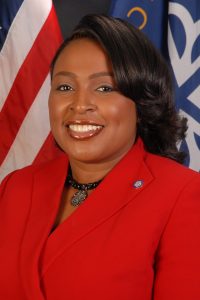 Candidate Email: Lovely@MayorLovelyWarren.com
Candidate Email: Lovely@MayorLovelyWarren.com
Website: www.MayorLovelyWarren.com
What are Rochester’s greatest transportation challenges?
Rochester’s greatest transportation challenges are:
1) Ensuring safe, affordable and convenient transit for our low-income families.
2) Building our infrastructure to encourage alternatives to cars while recognizing that the transition to alternatives remains a lengthy process. That means continuing to support our Complete Streets model and build additional bicycle/pedestrian infrastructure as well as supporting ride-share, bike share and transit services to truly enable an alternative transportation network in our City.
What are the top benefits our community would see by getting residents out of their cars and experiencing other modes of travel?
The greatest benefit is the creation of community and the building of relationships between neighbors, local merchants/business and community/governmental organizations.
By getting people to truly think locally (walking/biking distance) we can enhance neighborhoods and increase demand for services in our City’s commercial corridors. This will create opportunities and drive investment to areas that have seen chronic disinvestment due to the suburbanization of America.
What do you think City government can do to support public transit and create more equitable transportation options, especially in communities of color?
The City is eager to relaunch bike share in our community to empower City residents to utilize the resources in their neighborhood or nearby neighborhoods. That street level activity will also build upon itself and spur creative ideas on how to enhance it both economically and socially. A bike share relaunch in partnership with RTS should happen this summer.
We should also continue investments like the reconstruction of East Main Street with dedicated bike lanes and sidewalks for pedestrians to demonstrate how such infrastructure can be the catalyst to rebuild and reconnect neighborhoods.
Also, the City should push RTS to consider eliminating fares, where possible, within its system to further encourage the use of public transit.
What steps can the City take to improve accessibility to jobs for the 26% of Rochester residents who do not own or have access to a personal vehicle?
We should look to all of the items expressed above: 1) Expand bike infrastructure. 2) Restore bike share service, which is forthcoming. 3) Support ride-share services and encourage operators to adopt equitable practices for drivers and riders. 4) Encourage RTS to eliminate fares, where possible, to encourage use of the transit system. 5) Support the development of our local commercial corridors, like Bulls Head, N. Clinton Avenue, Jefferson Avenue, etc. to create jobs and services closer to where our residents live.
What steps will you take to encourage/incentivize residents (especially City employees) to commute using transportation options other than single occupant vehicles (walk/bike/bus/carpool/etc.)?
Again, we should look to all of the items expressed above: 1) Expand bike infrastructure. 2) Restore bike share service, which is forthcoming. 3) Support ride-share services and encourage operators to adopt equitable practices for drivers and riders. 4) Encourage RTS to eliminate fares, where possible, to encourage use of the transit system. 5) Support the development of our local commercial corridors, like Bulls Head, N. Clinton Avenue, Jefferson Avenue, etc. to create jobs and services closer to where our residents live.
How will you lead the community in reducing our transportation carbon footprint? Do you or would you be willing to take the bus, bike or walk to City Hall?
Under my leadership, Rochester is one of only 43 cities worldwide to be named an “A” city for its work combating climate change. We were recognized for our notable efforts, including our Sustainable Homes Rochester program, our expansive number of electric vehicle charging stations and our 2-MW solar farm located on the former Emerson St. landfill.
We have also been driving the adoption of renewable energy through the creation of Rochester Community Power (RCP). RCP is our community choice aggregation program to provide access to renewal electricity to city residents at lower rates than legacy electricity sources. RCP is in the process of conducting its education and enrollment campaign throughout our city. I will continue to support its efforts to ensure our residents have the ability to improve our environment while reducing their utility bills.
As it relates specifically to transportation, in addition to the responses provided above, I have directed our Department of Environmental Services to seek to purchase electric or other green vehicles wherever possible. In addition, DES explores green alternatives during the planning and design of our capital projects to ensure we are leading the way with the adoption of sustainable alternatives wherever possible.
In addition, we must continue to implement Rochester 2034 and the Comprehensive Access and Mobility Plan that informed it.
How specifically will you support the transportation vision outlined in Rochester 2034?
My administration was proud to complete Rochester 2034, our City’s first update to our comprehensive plan in over 15 years. I am committed to fulfilling this vision. The ongoing reconstruction of East Main St. is clear evidence of this work. With its dedicated and protected bike lanes, sidewalks and other traffic calming measures, the new East Main St. will serve as the first example of how we apply the vision of 2034 to future infrastructure projects.
In addition, I am creating a Rochester 2034 governance committee to ensure we implement the plan going forward and that decisions throughout City government are made in accordance with its principles.
What land use and economic development policies would you pursue to encourage job creation and development to remain in the city core, and better connect people in the city to employment opportunities?
My administration was proud to complete Rochester 2034, our City’s first update to our comprehensive plan in over 15 years. I am committed to fulfilling this vision. The ongoing reconstruction of East Main St. is clear evidence of this work. With its dedicated and protected bike lanes, sidewalks and other traffic calming measures, the new East Main St. will serve as the first example of how we apply the vision of 2034 to future infrastructure projects.
In addition, I am creating a Rochester 2034 governance committee to ensure we implement the plan going forward and that decisions throughout City government are made in accordance with its principles.
Are you satisfied with our current sidewalk and bus stop snow removal policies? What opportunities for improvement do you see?
No. There is more work to be done. However, it can’t be done by City government alone. We need partnerships with our businesses and community organizations. And, we need our residents to take responsibility where they can.
I am committed to exploring how to implement the following items from Rochester 2034; including:
- Prioritizing facilities according to higher levels of non-automobile traffic, such as mixed-use corridors, bus stops, routes to employment centers frequented by those who cannot or choose not to drive, key trail segments, and areas around large residential buildings.
- Creating partnerships with other entities to work together on snow removal.
- Researching equipment and technology available to more effectively construct and treat the surfaces of sidewalks and bicycle routes.
However, despite the need to do more and the partnerships necessary, it is important to note that Rochester is the only upstate city with an extensive sidewalk plowing program that occurs when there are more than four inches of snowfall. This long-standing effort continues to require a great deal of funding and resources and I remain committed to it.
Do you support a “Vision Zero” style approach to road safety, which includes lowered speed limits and other traffic calming practices and policies?
Yes!
What specific actions do you suggest to make Rochester safer for pedestrians and bicyclists of all ages and abilities?
We need to continue to design and build projects like the reconstruction of East Main St. with dedicated and protected bike lanes and sidewalks. We need to install additional traffic calming measures throughout the city and fully embrace all of the tenets of our Rochester 2034 comprehensive plan.
Would you favor the establishment of a bike/pedestrian advisory committee with the power to review road projects and make recommendations?
Yes. I envision this as part of our ongoing Rochester 2034 governance committee discussed above.
Rochester recently received a renewal of its “Bronze” level award as a bike-friendly community. One of the key steps to receiving “Silver” status is a dedicated budget for implementing our Bike Master Plan. Would you support a line item in the budget devoted to bike infrastructure?
I support continuing to build out our bike infrastructure as envisioned in our Rochester 2034 and associated CAMP, as well as, demonstrated by our East Main Street reconstruction and other infrastructure projects.
As you likely know, physical infrastructure, including bike infrastructure is typically funded with capital dollars and not operating funds. Therefore, I support the consistent and annual inclusion of such projects in our Capital Improvement Program and Capital Budget, along with the appropriate operating budget expenditures for maintenance and repair of such infrastructure.
Are there any other comments or thoughts you’d like to share about transportation and mobility in Rochester?
As I have shared throughout my responses, I am proud that my administration proposed, funded and completed our Rochester 2034 Comprehensive Plan, including the CAMP. In addition, I am glad we have shown our commitment to making these plans a reality via projects like the reconstruction of East Main Street. Prior to my administration, many of these ideas were proposed, but never realized. I am glad that together, with the support of our community we have made real progress in promoting walking, biking and other transportation alternatives. I understand there is more work to be done and there is more for me to learn. However, I know that I have worked in good faith to achieve these goals and would be honored by the opportunity to continue to work with you.
Candidates for City Council:
Luis Aponte
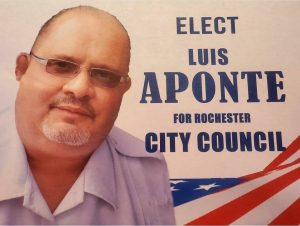 Candidate Email: Luisaaponte124@gmail.com
Candidate Email: Luisaaponte124@gmail.com
Website: www.facebook.com/LuisAponte4CityCouncil/
What are Rochester’s greatest transportation challenges?
Lack of routine financial support and city, county, and state educational programming.
What are the top benefits our community would see by getting residents out of their cars and experiencing other modes of travel?
One of the advantages is that it would have a huge impact on a person’s physical health. I also feel that by getting people out of their cars, it would give them an opportunity to actually see the assets of the community. With pandemic rules loosening slightly, I have witnessed many people taking advantage of not needing to find parking and visiting restaurants that have outdoor seating. People have a bigger tendency to visit local shops and may even help expand ridership amongst youth and children. Most novice riders usually are safe riders and I bet they will be more than willing to create some type of “community riding” programs.
What do you think City government can do to support public transit and create more equitable transportation options, especially in communities of color?
I feel that the city should make a budgetary line item for the promotion of a “safe riding’ program. Maybe it can be started through the City Recreation Department, and involve some type of partnerships with local bike enthusiast and bike shops. Many children in our poorer neighborhoods either don’t have bicycles or a safe place to ride. We need to get the right people at the table to brainstorm about how a system can be created. I think that having to apply for grant funding yearly makes some of the work already done not sustainable. We need to find funding by having the city and county leadership share the expenses.
What steps can the City take to improve accessibility to jobs for the 26% of Rochester residents who do not own or have access to a personal vehicle?
I think that the city should create a program with employers and RTS to give monthly stipends so that during inclement weather people could afford to get to work. The city may also do partnerships with businesses that ask employees to carpool. The city took the initiative to help transport people to a casino that was out of the county, so I think we should invest the same type of ideology to doing things within the city limits.
What steps will you take to encourage/incentivize residents (especially City employees) to commute using transportation options other than single occupant vehicles (walk/bike/bus/carpool/etc.)?
Obviously I didn’t read all the questions first, because I feel I added some ideas to some of the other questions. At the end of the day, things have to be made affordable. Jobs, Jobs, Jobs! In doing a little research, other cities gave tax breaks to employees that took the bus or rode bikes to work. First step would be for the city to use all of its resources to promote bicycling. Supporting the grassroot neighborhood associations may also help build an inner city biking community.
How will you lead the community in reducing our transportation carbon footprint? Do you or would you be willing to take the bus, bike or walk to City Hall?
Educating the community on options available to them and showing price comparisons on how much they can save may be an incentive for some. With the price of parking downtown, I don’t know how people afford to park downtown daily. My sister in law and her friends all carpool together and work downtown, they have done it for years. I am lucky enough to work close to home and sciatica prohibits me from walking long distances. I have grown fond of taking a train to Albany vs driving.
How specifically will you support the transportation vision outlined in Rochester 2034?
I feel that there has to be specific funding to help support the vision. Funding should include not only painting lanes in the road. Transportation studies need to be done to truly create safe riding lanes. We are blessed with the Genesee Water Ways and paths throughout the city/county. We need to continue supporting and creating new safe bike paths and an intermodal transportation center.
What land use and economic development policies would you pursue to encourage job creation and development to remain in the city core, and better connect people in the city to employment opportunities?
I would like to see new legislation that would help streamline the laws to get vacant and abandoned property issues resolved quicker. All proposals in regards to land use should always be presented to neighborhood residents for debate-approvals. Our city is rich in labor unions and a school district that is suffering. I am a supporter and a product of high school co-op programs that gave youth HOPE of having a good paying job and future after graduation. We must invest in our youth and the school district’s bright stars. Many will hopefully go on to become city home owners and becoming vested in their neighborhoods.
Are you satisfied with our current sidewalk and bus stop snow removal policies? What opportunities for improvement do you see?
I am not satisfied with the current processes used. I usually end up repairing my front lawn in spring because of damages rendered by the tractors. The front of my home is a bus stop for young children which is usually has to be cleaned in the morning by members of my family. I feel that there needs to be better equipment used and the job should be done by city employees so that there is a better accountability.
Do you support a “Vision Zero” style approach to road safety, which includes lowered speed limits and other traffic calming practices and policies?
The city has used some of these practices already across the city. Changing two lane roads into single lanes with bike paths is a good start. Curb cutouts and “curb appeal” also seems to slow down traffic. I do support the approach, but more needs to be done. To me, safety will always be key.
What specific actions do you suggest to make Rochester safer for pedestrians and bicyclists of all ages and abilities?
I feel that we must enforce the laws we have currently on the books, and maybe look into creating new legislation that may bring funding for enhancing street lighting. City forestry should also travel around the city to make sure tree limbs are not hindering lighting. Even with crosswalks and signage, it seems that some major intersections are horrendously unsafe. We need to do routine PSAs to remind motorist/pedestrians on the rules of the road. I would love to see the rails to trails program revisited to see if some of the areas could be paved like the areas near the canals.
Would you favor the establishment of a bike/pedestrian advisory committee with the power to review road projects and make recommendations?
I truly feel that this can be very exciting for residents that love cycling. Giving community members some ownership to programs like this would enhance many relationships, and may actually be a huge selling point for living in certain neighborhoods.
Rochester recently received a renewal of its “Bronze” level award as a bike-friendly community. One of the key steps to receiving “Silver” status is a dedicated budget for implementing our Bike Master Plan. Would you support a line item in the budget devoted to bike infrastructure?
This was my answer to one of the other questions. I must be honest, I thought we already had one that was run poorly! In order for this to grow and be successful, it needs to be funded and must have leadership that is passionate about the project.
Are there any other comments or thoughts you’d like to share about transportation and mobility in Rochester?
Compared to where we were even 5 years ago, I feel that we have done some strides in certain areas. I wish we would have made one huge transportation hub which included rail and busing. I feel we missed the mark on putting the RTS station where it is. I always felt that the bike lane markings should have been reflective in some way for the safety of bicyclist. I would like to see yearly “bike rodeos” where kids could get free helmets and rider education. Including bike giveaways would be great in a event like that. Just some of my thoughts. As a paramedic, I have seen many severe injuries due to lack of bike education and head injuries.
I would like to say Thank You for the opportunity to earn your support. These questions actually made me think more about transportation safety. Please feel free to reach me with any questions or clarification.
Leticia D. Astacio
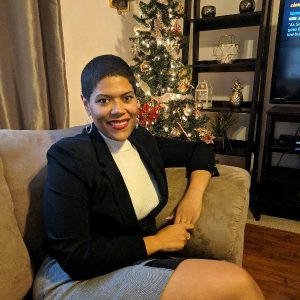 Candidate Email: astaciolaw@gmail.com
Candidate Email: astaciolaw@gmail.com
After several follow-up attempts, we did not receive a response from this candidate.
Mitch Gruber
Candidate Email: MitchForCityCouncil@gmail.com
Website: www.MitchGruber.com
What are Rochester’s greatest transportation challenges?
This city has been built for automobiles. People with cars get where they want to go, when they want to go there. People without cars struggle because of issues with public transit, bicycle infrastructure, and pedestrian walkways. The result is an issue of transit equity, which is the biggest transportation challenge we have.
What are the top benefits our community would see by getting residents out of their cars and experiencing other modes of travel?
Reduction in car travel would foster societal, environmental, and economic improvements. We’d see more connectivity between people, less emissions, and budgets that would focus more on people and less on cars.
What do you think City government can do to support public transit and create more equitable transportation options, especially in communities of color?
We can continue to invest in bicycle infrastructure and tighten the relationship between City and RTS.
What steps can the City take to improve accessibility to jobs for the 26% of Rochester residents who do not own or have access to a personal vehicle?
We must strengthen our routes for bicycle commuters. The upcoming bicycle boulevard initiative demonstrates a huge investment in commuter bicycling, but we have a lot more work to do. Most notably, we need an updated and improved bike master plan.
What steps will you take to encourage/incentivize residents (especially City employees) to commute using transportation options other than single occupant vehicles (walk/bike/bus/carpool/etc.)?
I will continue to try and model the behavior of someone who cares about multi-modal transit. In my time on Council, I’ve posted videos and talked at length about bike riding, walking, and taking the bus. In fact, pre-COVID I walked from my house to every City Council meeting, recorded it, and invited community members to join. I will continue to do this type of work.
How will you lead the community in reducing our transportation carbon footprint? Do you or would you be willing to take the bus, bike or walk to City Hall?
When we were still meeting in person, I walked to every single Council meeting and put it on Facebook live. I will continue to walk to Council, ride in every unity ride, and always make sure that the City is thinking about bike/peds in any construction project.
How specifically will you support the transportation vision outlined in Rochester 2034?
I believe that my actions of the last 3 years should demonstrate to Reconnect my full, 100% commitment to the transportation vision outlined in Rochester 2034.
What land use and economic development policies would you pursue to encourage job creation and development to remain in the city core, and better connect people in the city to employment opportunities?
One of the core economic development policies that the City adopted in recent years was to strengthen REDCO and move it out of City government. The result is an organization with more flexibility to facilitate economic development in specific ways. REDCO must encourage job creation and development in the city core, to better connect people to employment opportunities. Moreover, REDCO has the opportunity to be a transformative funder for transit equity, as they will be investing into commercial corridors. We must advocate for REDCO to think about transit equity whenever they invest in a commercial corridor.
Are you satisfied with our current sidewalk and bus stop snow removal policies? What opportunities for improvement do you see?
No. We need to continue to plow bike lanes, sidewalks, and bus stops. The issue has been, and will continue to be, money and resources. I will continue to advocate for more snow removal as we went a new budget year.
Do you support a “Vision Zero” style approach to road safety, which includes lowered speed limits and other traffic calming practices and policies?
Yes
What specific actions do you suggest to make Rochester safer for pedestrians and bicyclists of all ages and abilities?
Continue to invest in new bike infrastructure (Roc the Riverway, Bicycle Boulevards) and wayfinding tools .The City should also be partnering with Reconnect to create some of the videos and content that help facilitate safer streets.
Would you favor the establishment of a bike/pedestrian advisory committee with the power to review road projects and make recommendations?
Yes.
Rochester recently received a renewal of its “Bronze” level award as a bike-friendly community. One of the key steps to receiving “Silver” status is a dedicated budget for implementing our Bike Master Plan. Would you support a line item in the budget devoted to bike infrastructure?
Yes. I’ve also advocated for a bike/peds specialist on staff, and I will continue to do so.
Are there any other comments or thoughts you’d like to share about transportation and mobility in Rochester?
The City has made a lot of great improvements in the past three years, and I am proud of them. We also have a long way to go. I believe my track record has demonstrated my interest and ability to work with Reconnect to achieve shared goals. I will continue to do that work.
Anthony Hall, Jr.
 Candidate Email: hallforcitycouncil@yahoo.com
Candidate Email: hallforcitycouncil@yahoo.com
Website: www.facebook.com/AnthonyHallforRochesterCityCouncil
This candidate declined to participate in the questionnaire.
Brittan Hardgers
 Candidate Email: bhardgers4council@gmail.com
Candidate Email: bhardgers4council@gmail.com
Website: www.peoplesslateroc.com
What are Rochester’s greatest transportation challenges?
Rochester City residents deserve a public transportation system that is affordable, safe, has accommodating schedules and is structured by location that they can get to their chosen destination with ease. Scheduling and location of stops makes it extremely difficult for residents to get to their jobs, especially outside of City limits.
What are the top benefits our community would see by getting residents out of their cars and experiencing other modes of travel?
Reducing each resident’s and our city’s carbon footprint is invaluable to our city’s future. And we live in a City that experiences extreme poverty especially within our Black and Brown community. Providing affordable and accessible alternative modes of transportation isn’t just a benefit to our City, it is a necessity to many Rochesterians’ who can’t navigate the City any other way.
What do you think City government can do to support public transit and create more equitable transportation options, especially in communities of color?
Make sure that our communities are always the number one priority in our decision making. They also should be working closely with the county to make sure Rochesterians’ needs are met when using public transportation to access locations outside of the city.
What steps can the City take to improve accessibility to jobs for the 26% of Rochester residents who do not own or have access to a personal vehicle?
Increase stops, expand schedules and ensure that Rochestarian’s are able to access jobs outside of the city limits.
What steps will you take to encourage/incentivize residents (especially City employees) to commute using transportation options other than single occupant vehicles (walk/bike/bus/carpool/etc.)?
Support businesses who work to provide incentives for their employees to encourage alternative transportation.
How will you lead the community in reducing our transportation carbon footprint? Do you or would you be willing to take the bus, bike or walk to City Hall?
I commit to fighting to extend routes, schedules and making public transportation more accessible for us all. With those aspects in place I certainly am willing to participate in the same transportation alternatives that we are encouraging the community to utilize.
How specifically will you support the transportation vision outlined in Rochester 2034?
I support the study of how best we can serve underserved and marginalized populations within our community. Creating not just a utopian vision of Rochester, but a practical, substantial plan to make the average Rochesterians’ life better, easier and more successful. The elements that include assessment and implementation of providing economically beneficial options that also will benefit the environmental impact upon our world will have my full support.
What land use and economic development policies would you pursue to encourage job creation and development to remain in the city core, and better connect people in the city to employment opportunities?
I will support land use and economic development policies that encourage responsible business growth and economic growth without sacrificing the green standards and clean living that will sustain our community for generations.
Are you satisfied with our current sidewalk and bus stop snow removal policies? What opportunities for improvement do you see?
My Grandmother utilizes a walker to help her get around. Every winter, I worry about her ability to navigate the sidewalks safely. I was raised by my Grandmother. She saved my life and it was her that first taught me the importance of rallying and visiting legislatures and leadership to advocate for those most vulnerable in our community. Now is my opportunity to advocate for her and the rest of my elders to make sure their needs are met. I would love to see a more comprehensive plan to make sure that the streets, bus stops and sidewalks are clear and safe in all weather for our youth and elders.
Do you support a “Vision Zero” style approach to road safety, which includes lowered speed limits and other traffic calming practices and policies?
Yes I do. All Black Lives Matter and we can’t afford to lose one more life for any reason. If there are inexpensive and feasible ways to make small changes in traffic and transportation that can save lives, there is every reason to make those adjustments.
What specific actions do you suggest to make Rochester safer for pedestrians and bicyclists of all ages and abilities?
The increase of bike lanes to provide bicyclists a safe and convenient lane to ride.
Would you favor the establishment of a bike/pedestrian advisory committee with the power to review road projects and make recommendations?
I believe that we are all the experts of our own experience. By listening to the voices of those amongst us who are most affected by the decisions we make, we ensure that they make sense and are providing people what they actually want and need.
Rochester recently received a renewal of its “Bronze” level award as a bike-friendly community. One of the key steps to receiving “Silver” status is a dedicated budget for implementing our Bike Master Plan. Would you support a line item in the budget devoted to bike infrastructure?
By defunding the RPD and reallocating funds to various types of community programming, services and infrastructure changes, quality of life would most certainly improve for our city residents.
Are there any other comments or thoughts you’d like to share about transportation and mobility in Rochester?
Jonathan W. Hardin
 Candidate Email: mrjhardin@yahoo.com
Candidate Email: mrjhardin@yahoo.com
Website: www.jonathanhardin.nationbuilder.com
After several follow-up attempts, we did not receive a response from this candidate.
Jazzmyn Ivery-Robinson
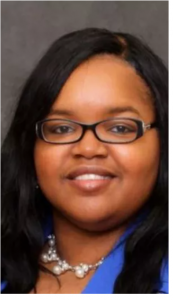 Candidate Email: jazzforcitycouncil@gmail.com
Candidate Email: jazzforcitycouncil@gmail.com
Website: www.jazzmynivery.com
What are Rochester’s greatest transportation challenges?
Although there are various transportation challenges that Rochester struggles with, I believe a large challenge is the way in which the City of Rochester provides transportation options for individuals with disabilities.
What are the top benefits our community would see by getting residents out of their cars and experiencing other modes of travel?
The top benefit for utilizing additional travel is an increase in mental and physical health.
What do you think City government can do to support public transit and create more equitable transportation options, especially in communities of color?
I believe that the city can work with RTS and other transportation services to all same day rides that allows for individuals with disabilities the ability to travel with reliability and the option to travel beyond Monroe County. I also believe in expanding the Uber services here to UberWAV which will allow for an additional alternative to an affordable wheelchair accessible vehicle.
What steps can the City take to improve accessibility to jobs for the 26% of Rochester residents who do not own or have access to a personal vehicle?
Advocating for and reallocating funds to expanding transportation services, increase bike lanes throughout the City of Rochester, and expanding employment opportunities throughout the city and closer to bus routes to allow for ease of access and less commute time.
What steps will you take to encourage/incentivize residents (especially City employees) to commute using transportation options other than single occupant vehicles (walk/bike/bus/carpool/etc.)?
Increasing education relating to transportation options. By talking with residents we can examine any hesitations that individuals may have and provide solution options. I will advocate to expand current transportation and bring new transportation options to the City of Rochester.
How will you lead the community in reducing our transportation carbon footprint? Do you or would you be willing to take the bus, bike or walk to City Hall?
I am not a stranger to using the bus system to City Hall. While a student in the Urban-Suburban program I had to utilize the RTS system to get from my home in the city to Pittsford Mendon. Throughout college I utilized the bus system provided by RIT, walked, or biked. I believe that we all can play a role in reducing our transportation carbon footprint. I would encourage the community to examine their personal needs, health, etc. and whenever they can to use an alternative method than a car. However, if a car is needed I would encourage carpooling, staying up to date on service maintenance, etc.
How specifically will you support the transportation vision outlined in Rochester 2034?
If elected, I will support the transportation vision outlined in Rochester 2034 by holding myself and accountable and my colleagues accountable in ensuring that we deliver on what has been laid out in the plan to ensure that we are providing a community where all residents can prosper.
What land use and economic development policies would you pursue to encourage job creation and development to remain in the city core, and better connect people in the city to employment opportunities?
I support a transit oriented development model. I believe in mixed use communities and while creating at minimum living wage jobs, affordable housing, grocery stores, etc. that are close to the bus terminal and within walking distance.
Are you satisfied with our current sidewalk and bus stop snow removal policies? What opportunities for improvement do you see?
I believe that there is always room for improvement. Right now according to the City of Rochester website residents are required to remove the snow in front of their homes when the snow is less than 4 inches. I believe there is an opportunity to reallocate funds for the removal of snow by city employees when the snow is less than 4 inches as this will help not only walkers, bikers, but also individuals within wheelchairs.
Do you support a “Vision Zero” style approach to road safety, which includes lowered speed limits and other traffic calming practices and policies?
Yes
What specific actions do you suggest to make Rochester safer for pedestrians and bicyclists of all ages and abilities?
I am a supporter in expanding bike lanes throughout the City.
Would you favor the establishment of a bike/pedestrian advisory committee with the power to review road projects and make recommendations?
Yes
Rochester recently received a renewal of its “Bronze” level award as a bike-friendly community. One of the key steps to receiving “Silver” status is a dedicated budget for implementing our Bike Master Plan. Would you support a line item in the budget devoted to bike infrastructure?
Yes
Are there any other comments or thoughts you’d like to share about transportation and mobility in Rochester?
Willie J. Lightfoot
Candidate Email: WillieLightfoot4CityCouncil@gmail.com
Website: www.WillieLightfoot.com
We did not receive a response from this candidate.
Stanley Martin
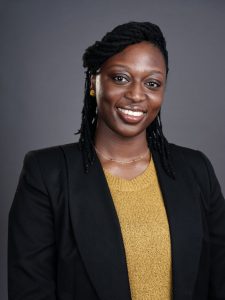 Candidate Email: Iknowstanleymartin@gmail.com
Candidate Email: Iknowstanleymartin@gmail.com
Website: www.peoplesslateroc.com
What are Rochester’s greatest transportation challenges?
Our challenges lie in the inability of our community members to cheaply, efficiently, and safely move throughout our city landscape. These challenges are felt most often and most harshly by Black and Brown communities and are inextricable from questions of class. There are people in our community facing hours of daily commuting in order to get to work on public transportation. Problems like this stem not only from our flawed public transportation system, but also the inaccessibility of walking and biking as reliable transportation and the fact that so many of our city residents do not have reliable employment within a short distance of their homes.
Like so many other matters, our transportation challenges are intersectional and must be view through a holistic lens if we are to come up with sustainable and equitable solutions. This starts with the centering of communities that are most affected by the flaws and allowing them to speak to the changes that would best serve them. It also means reallocating funding to enable bold and meaningful changes to the way we address transportation in our city.
What are the top benefits our community would see by getting residents out of their cars and experiencing other modes of travel?
When people walk, bike, run, or skate through their community they connect and interact with it in a very different way. Stopping to look through the windows of small businesses, taking a detour through a park or along the riverway to admire our incredible local landscape, saying “hello” to the person going by; these things help build a community. These modes of transportation are also cheaper, better for the environment, and better for the body than driving.
It is important that we make sure all of our city roadways and sidewalks are equally accessible to these modes of travel, and that all of our communities are given the same resources and attention as we improve on our infrastructure and cultivate green space.
What do you think City government can do to support public transit and create more equitable transportation options, especially in communities of color?
Bringing the most affected communities to the table in order to decide on the solutions, rather than deciding on their behalf is the most important part of any solution. Bus riders and drivers are not only the most affected by these, they are also the premiere experts on them. Additionally we can allocate funds to improve on the routes, the accessibility of our buses and stations, and reduce the cost for our riders.
We also need to find ways to keep our community safe while using public transport that does not involve policing. People using public transportation are disproportionate targeted by police, which is problematic enough without considering how many Black and Brown youth rely on public transportation. Equitable transportation means making sure that riders are being subjected to profiling and surveillance by RPD.
What steps can the City take to improve accessibility to jobs for the 26% of Rochester residents who do not own or have access to a personal vehicle?
A more efficient public transportation system is a part of this solution, but we also need to make sure that our communities have good, reliable jobs within their neighborhoods. Every person in Rochester should have the opportunity to support themselves and their family within walking distance.
What steps will you take to encourage/incentivize residents (especially City employees) to commute using transportation options other than single occupant vehicles (walk/bike/bus/carpool/etc.)?
When elected, I will advocate for commuter benefit programs where employees can use pre-tax income to pay for various forms of public transportation as we move towards a system where it can be permanently free for all our residents. If we are serious about reducing emissions, serving our communities, and reducing vehicle traffic for a Vision Zero approach to transportation then we need to get serious about solutions.
How will you lead the community in reducing our transportation carbon footprint? Do you or would you be willing to take the bus, bike or walk to City Hall?
I am certainly willing to take the bus, bike, or walk to City Hall. I also support the purchase of additional electric busses until the entire RTS fleet is fully electric by 2030.
How specifically will you support the transportation vision outlined in Rochester 2034?
“I will support the transportation vision outlined in Rochester 2034 through the following measures:
- Advocate for complete streets, led by community design, that are accessible to pedestrians, bicyclists, transit riders and motorists.
- Advocating that fees for public transit be eliminated
- Exploring options for additional modes of public transit including a city-wide light rail
- Partnering with advocacy organizations such as Reconnect Rochester and frontline community members to advocate that policies best align with community needs aspirations.”
What land use and economic development policies would you pursue to encourage job creation and development to remain in the city core, and better connect people in the city to employment opportunities?
Community Land Trusts (CLT) can be an invaluable resource for youth employment, community education, quality nutrition, climate justice and housing development without displacement. I fully support CLT initiatives to further community control of residential & commercial spaces. When elected I work to further empower CLTs through public policy.
I also support a new vision for civilian-led public safety that directly engages and employs folks from marginalized communities in Rochester in good paying, unionized jobs. In particular, creating Community Safety Centers that would provide a wide array of services including family assistance, conflict mediation, civilian crisis intervention, and funds to compensate individuals and families who have experienced racism and other forms of discrimination. This new vision would also develop sites offering paid peer counseling, treatment programs, legal services & case management to improve housing, health care, employment opportunities, immigration advocacy & public benefits.
This would include enacting a Civil Life Corps to work with communities to help resolve day-to-day programs and address community needs including access to quality transportation, housing, voting rights, environmental equity & conservation. It would also involve creating civilian response teams who are trained in first aid, car mechanics, and de-escalation & conflict resolution to respond to traffic safety incidents. This plan can help create real employment opportunities to uplift neighborhoods across Rochester and puts the control exactly where it should be: in the community.
Are you satisfied with our current sidewalk and bus stop snow removal policies? What opportunities for improvement do you see?
The City of Rochester must implement stronger snow removal policies. With such snow-intensive winters, whole City blocks can be rendered inaccessible to frail older adults and people with mobility disabilities. It can also pose a tremendous a risk of injury due to falls. When elected, I will fight to make sure that we have comprehensive snow removal policies in all neighborhoods that ensure accessibility throughout the Fall and Winter months.
Do you support a “Vision Zero” style approach to road safety, which includes lowered speed limits and other traffic calming practices and policies?
Traffic-related deaths and injuries are not an inevitability, but are tied to planning and policy. I support a “Vision Zero” style approach to road safety, including lowered speed limits, pedestrian zones, barriers that separate cars from bikes, and other measures. In addition, to re-imagine transportation & traffic safety, I support the use of civilian response teams who are trained in first aid, car mechanics, de-escalation & conflict resolution. I fully support community input and influence in determining appropriate policies needed to improve traffic safety in our neighborhoods. This includes consulting and soliciting input from neighborhood organizations, tenant unions, individuals & families, and faith communities.
What specific actions do you suggest to make Rochester safer for pedestrians and bicyclists of all ages and abilities?
To make Rochester safer for pedestrians and bicyclists of all ages and abilities, I support complete streets, led by community design, that are accessible to pedestrians, bicyclists, transit riders and motorists. These may include bike lanes, roundabouts, improved, comfortable & convenient transportation stops, median green spaces, street art, and other features.
Would you favor the establishment of a bike/pedestrian advisory committee with the power to review road projects and make recommendations?
I fully support the establishment of a bike/pedestrian advisory committee with the power to review road projects and make recommendations. I believe that we are all the experts of our own experience. By listening to folks directly affected by these decisions, we will ensure that public policies align with community needs.
Rochester recently received a renewal of its “Bronze” level award as a bike-friendly community. One of the key steps to receiving “Silver” status is a dedicated budget for implementing our Bike Master Plan. Would you support a line item in the budget devoted to bike infrastructure?
I am a strong proponent of transitioning funds away from policing and into community-based services and infrastructure, which includes investing in alternative modes of transportation such as bike infrastructure.
Are there any other comments or thoughts you’d like to share about transportation and mobility in Rochester?
We have a long way to go before we achieve equitable, reliable, and sustainable transportation in this city, but if we continue to organize and work together towards real solutions with an intersectional mindset then we can achieve the kinds of changes that we all know our community needs and deserves. If you support this agenda, or have any input on how we can improve our positions regarding transportation here in Rochester, please visit Peoplesslateroc.com and get connected with our campaign.
Miguel Melendez
Candidate Email: melendezforcouncil@gmail.com
Website: www.melendezforcouncil.com
What are Rochester’s greatest transportation challenges?
There are a few… First, I believe our public transportation system is still challenging. I know that we are in the process of making changes but it still takes too long to travel in this City with public transit. I also believe that our communities lack public transit amenities such as street furniture and bus shelters. Over time, we have removed more and more of these features instead of repairing/replacing them. I also believe we have to increase our active bike lanes and “sharrows.” We have come a long way since that time and I believe the work of that committee helped set the stage for increasing access in Rochester. Since joining council, I have helped improve the bicycle boulevards efforts and sought increased wayfinding, something I will continue to advocate for as a sitting councilmember. We still have a lot of work to do. I think dedicated bike lanes and increased biking infrastructure are great next steps and hopefully the East Main Street project will be a great example of what we can do as we approve large road reconstruction projects. I also believe we have to improve walkability in our communities as part of the Roc 2034 comp plan. We need to couple our placemaking strategies with our transportation efforts to ensure people have access to new destinations.
What are the top benefits our community would see by getting residents out of their cars and experiencing other modes of travel?
I think it helps create a sense of community. Everything is different in a neighborhood when you have neighbors walking instead of driving past each other. I have seen this benefit with the opening of the international plaza, something that is near and dear to my heart as part of my work in the El Camino neighborhood at Ibero. In the neighborhood vision plan, residents were clear; they wanted a neighborhood that had destinations, walkability, and where they could recirculate their dollar. Creating destinations AND making those destinations accessible are both important. I worked with residents to apply for and implement a “Complete Streets Makeover” project on North Clinton Avenue. Through that project, we painted two crosswalks, bump-outs, a ramp for accessibility, and public art across North Clinton Avenue to the International Plaza site (before it was built) to demonstrate the vision of neighbors in the area. While we certainly wanted to do more with the project (such as add a temporary median on North Clinton Avenue), we have advocated for the city to add permanent crosswalks in the future. So the benefits from my perspective are improved quality of life, improved health, improved safety, cost savings for the resident and reduced negative impact on climate change.
What do you think City government can do to support public transit and create more equitable transportation options, especially in communities of color?
City government can improve transit by improving street amenities, advocating for the creation of more East/West bus routes (some of which is occurring in Reimagine RTS, such as the Upper Falls BLVD route), continuing to develop street infrastructure (dedicated bike lanes, bike lanes, sharrows, wayfinding, etc.), developing more transit options (PACE bikes, increased bus route frequency, etc.) and maintaining an affordable system for the public by investing in public transit, as needed and appropriate.
What steps can the City take to improve accessibility to jobs for the 26% of Rochester residents who do not own or have access to a personal vehicle?
I believe, wholeheartedly, there is an opportunity to bring some of the jobs our citizens take closer to home. For example, we have learned so much during the pandemic and working remotely is now a way of life. While not everyone has access to technology, we have access to vacant warehouse and old manufacturing spaces all across the city in our urban neighborhoods that could be repurposed. I do not understand why we need to have our citizens take two buses to work at a call center in Henrietta when people could work at a call center up the street. With that being said, let me answer the question. What I have said in my other responses rings true here. I also think we can encourage employers to help with incentives for employees. Major employers should be able to invest some resources in transportation. Training and placement programs like YAMTEP have figured out how to provide transportation to clients to employment opportunities. Coming out of the pandemic, I think rideshare/carpool options should be considered.
What steps will you take to encourage/incentivize residents (especially City employees) to commute using transportation options other than single occupant vehicles (walk/bike/bus/carpool/etc.)?
With the transit center being so close to City Hall, I think there are great opportunities for City employees to reduce their carbon footprint. However, there are many jobs do require constant transportation in the field (such as inspectors) where it would be hard to find an alternative. As a councilmember, I believe the best way to encourage and incentivize residents is to improve the amenities. If we can continue to invest resources to create a more robust system where citizens see themselves utilizing alternative transportation methods.
How will you lead the community in reducing our transportation carbon footprint? Do you or would you be willing to take the bus, bike or walk to City Hall?
I started my career riding a bus to and from work. I did not start driving until a year into my professional career. I drive now out of necessity and a packed calendar. However, I certainly would be willing to push myself utilize the bus more often, particularly to City Hall.
How specifically will you support the transportation vision outlined in Rochester 2034?
I believe in connecting all the broken links in our trail systems. I will support existing bridges, advocate for the running track bridge to be completed, continue to invest in bike blvds and support the advancement of CAMP. I have been and will continue to do these things. As part of the Capital improvement plan for the City, many of these issues are in the current 5-year plan. I also believe that there is more opportunity with the American Rescue Plan to support infrastructure projects, we are still awaiting for guidance from the federal government. So, this is on the radar of the current administration and I believe current councilmembers do see the value in these efforts. What we have to do is bring transportation infrastructure to more of the side streets. I will continue to work on all of these things as a sitting councilmember and hope to do more to improve infrastructure over the next several years.
What land use and economic development policies would you pursue to encourage job creation and development to remain in the city core, and better connect people in the city to employment opportunities?
I would incentivize repurposing existing infrastructure to create more economic activity in city neighborhoods. I believe that ultimately we have to find new and innovative ways to keep more dollars in our community and recirculate those resources as often as possible. I feel we have too many chain businesses interested in locating on our commercial corridors (family dollar stores being a prime example) that put very little back into our neighborhoods. Vacant buildings are assets and we have to find ways to incentivize reinvestment in infrastructure to private owners. I also believe we have many jobs in our region but there is a disconnect. I will work to help fix the community to opportunity pipeline, so that inner city residents are aware and connected to available options. I believe the office of community wealth building under the Mayor’s office can be a tremendous asset in this space.
Are you satisfied with our current sidewalk and bus stop snow removal policies? What opportunities for improvement do you see?
I think the snow removal policy is decent but we need to improve in two areas. First, I would like to see better clearance for ADA ramps/cross walks and at bus stops/bus shelters. Too often we see people riding or walking in the street because of this issue. Second, I also believe the City should consider snow removal on sidewalks for residential streets. How we achieve this might be a challenge. I know it is the responsibility of the resident to remove snow in front of their homes, but often, people neglect that part of the responsibility. I think a policy that targets snow removal during major storms (i.e., maybe over 10 inches of snowfall?) should be considered, at a minimum. This could be similar to our high grass & weed policy.
Do you support a “Vision Zero” style approach to road safety, which includes lowered speed limits and other traffic calming practices and policies?
I believe we should lower the speed limit on residential streets to 25 mph. I have been part of the drive 2 be better planning efforts and signed onto various advocacy letters/efforts to reduce the speed limit in the city of Rochester. I also believe we should invest more in traffic calming infrastructure such as bump-outs, tree plantings, raised crosswalks, painted crosswalks, and speed bumps. I understand there is a limit to some of these strategies but traffic speeds in a neighborhood certainly impact quality of life. It impacts play in neighborhoods too, as parents often site speeding cars as one of the reasons they do not allow their children to play outside. I do believe traffic deaths are preventable.
What specific actions do you suggest to make Rochester safer for pedestrians and bicyclists of all ages and abilities?
1.) Lowering the speed limit on residential streets (25 mph)
2.) Increasing road infrastructure such as bump-outs and exploring more road diets on major arterial streets.
3.) Plant more trees in tree lawns (proven to slow traffic)
4.) Increase use of protective bike lanes as a future strategy
There are many other suggestions in other answers that I wont repeat.
Would you favor the establishment of a bike/pedestrian advisory committee with the power to review road projects and make recommendations?
I would be. I have been part of such efforts at community tables, but institutionalizing the conversation in government makes sense. I also know that in addition to the City, GTC and others have a say and sway in the process. We have to figure out how to make these things work together.
One of the issues you will always have to contend with is businesses and “their” parking. We have to find more ways to engage business owners in these discussions too, so they can understand the long-term value of the paradigm shift.
Rochester recently received a renewal of its “Bronze” level award as a bike-friendly community. One of the key steps to receiving “Silver” status is a dedicated budget for implementing our Bike Master Plan. Would you support a line item in the budget devoted to bike infrastructure?
Yes. I have supported various biking infrastructure projects in the past 6 months on council. I was part of the bike master planning process in a limited way as part of my work with Healthi kids. I fully support the plan.
Are there any other comments or thoughts you’d like to share about transportation and mobility in Rochester?
I am accessible as a councilmember. Reach out. Include me. Invite me. If I can attend meetings or be helpful, I want to be. I know I have only been on council for 7 months but I feel I have already contributed greatly to these conversations at city hall and have a great relationship with PPW chair.
Miquel A. Powell
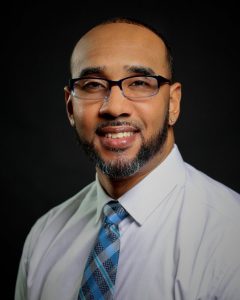 Candidate Email: miquelpowell@yahoo.com
Candidate Email: miquelpowell@yahoo.com
Website: www.facebook.com/Miquel-Powell-BSW-for-City-Council-Rochester-NY-350270019114691
After several follow-up attempts, we did not receive a response from this candidate.
Jasmin Reggler
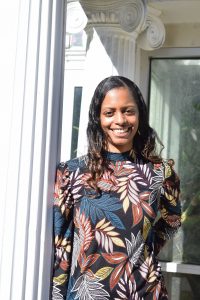 Candidate Email: Jasmin@jasminforjustice.com
Candidate Email: Jasmin@jasminforjustice.com
Website: www.jasminforjustice.com
What are Rochester’s greatest transportation challenges?
Rochester’s greatest transportation challenges are timely and reliable transportation options.
What are the top benefits our community would see by getting residents out of their cars and experiencing other modes of travel?
Walking, biking and using public transportation are options that would reduce fossil fuel emissions in our city. Additionally, residents who reduce their car usage experience greater community contact and engagement while also getting more exercise.
What do you think City government can do to support public transit and create more equitable transportation options, especially in communities of color?
To support public transit and transportation options, the City government can approve funding increases for the RTS to operate more efficiently. City government can also increase the amount of bike lanes as well as maintain the current bike route system. Currently in Rochester there are many community organizations that provide bikes free of charge to residents. The City might collaborate with these organizations to support the efforts of providing bikes free of charge.
What steps can the City take to improve accessibility to jobs for the 26% of Rochester residents who do not own or have access to a personal vehicle?
As a resident without a personal vehicle, by choice, I have experienced first-hand the inadequacies of our public transportation options. Often the RTS runs late or misses stops altogether—this is unacceptable. I understand RTS is rolling out new routes and time standards this year and I will wait to comment any further until the changes have taken place. Consistency, reliability and abundant route options are the most important considerations here.
What steps will you take to encourage/incentivize residents (especially City employees) to commute using transportation options other than single occupant vehicles (walk/bike/bus/carpool/etc.)?
Within the City network I would encourage employees to carpool by creating a ride-share network. This online option would allow employees to offer/accept rides that were posted. In addition to offering incentives to riding public transportation, such as drastically reduced bus pass rates. More bike parking options would be needed to ensure employees had parking access.
How will you lead the community in reducing our transportation carbon footprint? Do you or would you be willing to take the bus, bike or walk to City Hall?
As a resident without a personal vehicle, I will lead the community by example. I will share my experiences and encourage others to do the same. I would be willing to commute to City Hall to raise awareness of our collective carbon footprint.
How specifically will you support the transportation vision outlined in Rochester 2034?
I will support the transportation vision of Rochester 2034 by participating in community feedback sessions. As a community member I will be using my voice to represent and advocate for greater and more equitable transportation options for Rochester residents.
What land use and economic development policies would you pursue to encourage job creation and development to remain in the city core, and better connect people in the city to employment opportunities?
With the legalization of cannabis in NY there will be a revitalization of opportunities in that field. I’d be sure to advocate for those jobs staying in the city core for our residents–creating job creation and sustained employment opportunities right in Rochester.
Are you satisfied with our current sidewalk and bus stop snow removal policies? What opportunities for improvement do you see?
Clear sidewalks and bus stops are a must in our city. Due to the harsh winters, this must be made a priority.
Do you support a “Vision Zero” style approach to road safety, which includes lowered speed limits and other traffic calming practices and policies?
I am comfortable with where the speed limits are at and would work in other area to reduce our carbon footprint.
What specific actions do you suggest to make Rochester safer for pedestrians and bicyclists of all ages and abilities?
Improved spacing and visibility of bike lanes.
Would you favor the establishment of a bike/pedestrian advisory committee with the power to review road projects and make recommendations?
Yes, absolutely. Currently community groups are established and I will work alongside folks who are already working on these issues.
Rochester recently received a renewal of its “Bronze” level award as a bike-friendly community. One of the key steps to receiving “Silver” status is a dedicated budget for implementing our Bike Master Plan. Would you support a line item in the budget devoted to bike infrastructure?
Yes, I would support funding for the infrastructure to be improved. Not only is biking important to achieving our goals of a reduced carbon footprint, but the activity itself is a great benefit for quality of life.
Are there any other comments or thoughts you’d like to share about transportation and mobility in Rochester?
I am a resident who does not own a personal vehicle. I believe more Rochester residents would feel comfortable to use biking, public transportation, car-pooling if they felt supported by the infrastructure. We can do this!
Victor Sanchez
Candidate Email: info@votevictorsanchez.com
Website: www.votevictorsanchez.com
What are Rochester’s greatest transportation challenges?
Rochester has a deep-rooted car culture which has unfortunately shaped the way we develop our City and the policies we have set in place. Shifting that culture and undoing the care-centric infrastructure we have developed, is a huge challenge and it will require community support, strategic planning, and dedicated funding. We are lacking the public transit system that is convenient and street/road systems that are people-focused making it easy to walk and bike as a way to get around.
What are the top benefits our community would see by getting residents out of their cars and experiencing other modes of travel?
Moving away from relying on cars as a way of travel will have great benefits on the environment as well as community and personal health. A majority of the carbon emissions come from vehicles and reducing the amount of cars on the road will only support the work that needs to be done to achieve cleaner air and combat climate change, both of which have a negative impact on the health of our communities. Reducing vehicles on the road would also create safer streets, and reduce the risk of vehicular accidents and maybe even shift the way neighbors interact and utilize the streets to do that.
What do you think City government can do to support public transit and create more equitable transportation options, especially in communities of color?
The systemic racism that has segregatedcommunities of color that have gone undeveloped and forgotten needs to be undone.The communities impacted need to be brought into the conversation. The citygovernment needs to work with other elected officials at all levels ofgovernment to continue and grow the support of our transit system and work withRTS to ensure that stops and routes are in all communities, especially thosethat rely on it most. We need to prioritize alternative modes oftranspiration, such as rideshare programs. We also need to shift ourdevelopment to assure our residents can get to resources and serviceswithin a short commute accessible by walking or cycling.
What steps can the City take to improve accessibility to jobs for the 26% of Rochester residents who do not own or have access to a personal vehicle?
The city needs to work with businesses, other municipalities, and RTS to assure that there are routes that go to where the jobs are. The city also needs to improve the development of businesses within areas of the city and work to develop business in a strategic approach where transit lines exist. We also need to assure that there is the infrastructure to support other forms of transportation like walking and cycling.
What steps will you take to encourage/incentivize residents (especially City employees) to commute using transportation options other than single occupant vehicles (walk/bike/bus/carpool/etc.)?
The main step to encourage anyone to use other modes of transportation is to assure other methods are convenient. The city needs to work with RTS to assure routes are accessible and frequent. The City also needs to make sure that any rideshare programs are easy to use for residents to get to their needed jobs. The city government should lead by example and incentive city employees to use public transportation by providing vouchers or bus passes. The city government also has the power to set a strategic plan to develop any new businesses on transit lines or setting codes prioritizing bike storage over parking in new development.
How will you lead the community in reducing our transportation carbon footprint? Do you or would you be willing to take the bus, bike or walk to City Hall?
I look forward to being able to take the bus to City Hall, I wish it was convenient and accessible to take public transit to my day job now. I will continue and do more to support events like Roc Transit Day, and cycling events as well as promote more when I use modes of transit that aren’t my car.
How specifically will you support the transportation vision outlined in Rochester 2034?
As someone that was very involved with gathering input for the 2034 Plan, I am excited for the opportunity to support and facilitate the implantation of this plan. A majority of my conversations revolved around increasing walkability and multi-model transportation; I will assure that any remodeling and development of streets are done with this vision in mind and done in a way that highlights safety and transportation choice.
What land use and economic development policies would you pursue to encourage job creation and development to remain in the city core, and better connect people in the city to employment opportunities?
We have a great opportunity to prioritize and encourage the creation of small businesses through, zoning and eliminate barriers such as minimum square footage, parking requirements which can hinder someone from starting a business. We need to invest in our people encourage entrepreneurial ship through providing support, space, and resources. We have a mixture of industrial skills and innovative technical talent from our universities and industrial past. We need to be creative in finding innovative ways to bring those things together in two the new era.
Are you satisfied with our current sidewalk and bus stop snow removal policies? What opportunities for improvement do you see?
I am not satisfied with our existing work, it never feels like there is sufficient sidewalk snow removal, and don’t see much done when it comes to bike lanes or bus stops. I know resources and funding for this work are a challenge. We need to prioritize streets and transit as a matter of safety and equity and having dedicated employees to maintain our streets would be a priority of mine.
Do you support a “Vision Zero” style approach to road safety, which includes lowered speed limits and other traffic calming practices and policies?
Yes, I fully support a “Vision Zero” style approach including reducing speeds. I have been very appreciative and supportive of some of the innovative ways to achieve this vision through the complete street work that has been going on. I do believe reducing the use of cars and car culture in Rochester is the best way to achieve this vision.
What specific actions do you suggest to make Rochester safer for pedestrians and bicyclists of all ages and abilities?
We need to continue and increase our investment in biking infrastructure. I don’t agree that painted lines for bikes is enough and want to see dedicated bike lanes that are raised or have some kind of barrier from car traffic.
Would you favor the establishment of a bike/pedestrian advisory committee with the power to review road projects and make recommendations?
Yes, this would be a great opportunity to partner with organizations like Reconnect and the Cycling Alliance to assure those that have been strong advocates are part of the process. It will be important that there is true empowerment of the committee and not just symbolic
Rochester recently received a renewal of its “Bronze” level award as a bike-friendly community. One of the key steps to receiving “Silver” status is a dedicated budget for implementing our Bike Master Plan. Would you support a line item in the budget devoted to bike infrastructure?
Yes, dedicated budget and resources are important to achieve several of the goals in the previous questions.
Are there any other comments or thoughts you’d like to share about transportation and mobility in Rochester?
We need to follow our plan and prioritizes walkability and multimodal transportation. We need to change our culture from being car-focused, we need to shift the mindset of having the need of people driving to the front door of their destination.
Kim Smith
Candidate Email: thepeoplesslate@gmail.com
Website: www.peoplesslateroc.com/
After several follow-up attempts, we did not receive a response from this candidate.
Alex White
 Candidate Email: AlexWhiteforRochester@gmail.com
Candidate Email: AlexWhiteforRochester@gmail.com
Website: www.AlexWhiteforRochester.org
What are Rochester’s greatest transportation challenges?
Rochester, like most American Cities has been built around the car culture. We allowed cars to destroy public transportation systems and gave it primacy over any methods of transportation that remained. Yet the future does not belong to cars and even the present is becoming filled with other diverse transportation options. So the problem of how to create a modern transportation system that moves people effectively with both public transit and wide variety of private options including, walking, bikes, scooters, skateboards, wheelchairs, as well as cars, is the fore most problem facing our city. Besides this Rochester has poorly invested in public infrastructure which has forced a hub and spoke bus system which is inefficient in every way and serves the public poorly. Finally we have almost no fixed route infrastructure aging bridges, and over built road system.
What are the top benefits our community would see by getting residents out of their cars and experiencing other modes of travel?
Abandoning cars has huge health benefits to a community. Besides the health value to an individual of any form of active transport, the Covid crisis has shown getting out of cars will rapidly improve the air quality. There has long been an understanding of the link between air pollution and asthma (https://www.epa.gov/sciencematters/links-between-air-pollution-and-childhood-asthma), but there also seems to be a link to heart disease (https://www.epa.gov/sciencematters/linking-air-pollution-and-heart-disease) and even cancer and dementia. An improvement in air quality would greatly improve the health of all the citizens and would also help fight global climate change which is straining the planets ability to support large mammals of all types including humans.
What do you think City government can do to support public transit and create more equitable transportation options, especially in communities of color?
The city has little power to change the RGRTA policy but it should be working with government officials at all levels to fight for additional transportation dollars to start building the fixed route transportation system which will someday have to replace personal use vehicles. Further it can pressure the county and RGRTA to try to improve its systems. It can also do some bus stop improvements like benches, shade, and snow shoveling of bus stops to make them more convenient for the users. Finally it can use small measures to encourage its own workers to use public transit.
What steps can the City take to improve accessibility to jobs for the 26% of Rochester residents who do not own or have access to a personal vehicle?
Of course the key to this is improving the public transit system but the city should also have ride share connections opportunities on their web page. They also need to get the bike share program to reach more at need neighborhoods. Of course transportation is one of the many facilitators that allow people improve their employment but there are others that the city can use to improve employment. Many employers are already on public transit lines but the jobs require training, degrees, or certification like Certified Nursing Assistant programs. The city needs to do more to make scholarship or training opportunities available for people so they can access jobs like this which would lift people out of poverty and are easily accessible to the population that most needs it.
What steps will you take to encourage/incentivize residents (especially City employees) to commute using transportation options other than single occupant vehicles (walk/bike/bus/carpool/etc.)?
I have long had a number of little things I think would improve the city and one is to eliminate free parking for employees. Instead the city should offer reduced rate or free bus passes, expanded bicycle lock up, storage and repair facilities, and work with RGRTA to have bus routes be more convenient for city services and their employees.
How will you lead the community in reducing our transportation carbon footprint? Do you or would you be willing to take the bus, bike or walk to City Hall?
I find myself frequently having to go downtown and I frequently bike or walk there from my house. For years I have been biking or walking to work at my business on Monroe Ave. As a business owner I have encouraged others to try to get bike rakes near their businesses. I fully intend to actively transport to city hall as often as I can and will encourage others to do the same.
How specifically will you support the transportation vision outlined in Rochester 2034?
Guiding transportation principles seem to settle on two transportation ideas walk ability and multi-modal transportation. Both principles I believe in. I hope to bring this to city council so that every project in the city can further these ideas. Too often we develop solely to increase density without a focus on creating walk ability and provide for other transportation. Even though we have developed many trails and even a alternative bike routes these seem to be very secondary to other concerns in the city and I hope to change this.
What land use and economic development policies would you pursue to encourage job creation and development to remain in the city core, and better connect people in the city to employment opportunities?
For years the city has been subsidizing housing in the city core on the belief that that would create a more vibrant city center but that has failed to happen and is unlikely to work as the density needed for even a grocery store is unlikely to ever be reached in the city center. Further despite billions of investment there have been few full time jobs created. Instead of investing in buildings the city needs to invest in people, incubators and space designed for the 21st century. Further the zoning code needs to be modernized to fully recognize home businesses, urban agriculture, work from home spaces, and garage start ups. Of course there is also the opportunity to create jobs through aging in place and housing for persons with disabilities. As such all new construction should be meet the highest standards for persons with disabilities.
Are you satisfied with our current sidewalk and bus stop snow removal policies? What opportunities for improvement do you see?
No we are currently doing a worse job at sidewalk cleaning than we did 100+ years ago. Our plows are in many cases not the right tools for this and contracting it out has resulted in less plowing at higher costs. We can not rely upon residents to shovel as even one failure to do in a block renders the whole block impassable. So what we need is more wire brush cleaners, more frequent routes, and a taking this task back in house so we can prioritize it to the routes that most need it. Finally we need to have people who’s only job is cleaning curb cuts and bus stops.
Do you support a “Vision Zero” style approach to road safety, which includes lowered speed limits and other traffic calming practices and policies?
Ideally I support zero cars, the regained parking space alone makes this a great idea but that is unlikely to happen. I feel that we need to do a better job of focused traffic calming to where it is important. After all some of these tactics actually make other active transportation methods more difficult or dangerous, such as narrowing streets which then interrupts bike routes. Yet we need to use a variety of tools to reduce speeds near parks, schools, and other places that children play.
What specific actions do you suggest to make Rochester safer for pedestrians and bicyclists of all ages and abilities?
I like the concept of one way streets with a special lane for non motorized transportation but this is unlikely to happen. What is doable and something I really want to do is get bike boxes at all intersections that have a bike lane at any part of the intersection.
Would you favor the establishment of a bike/pedestrian advisory committee with the power to review road projects and make recommendations?
Yes I would and would work to do this.
Rochester recently received a renewal of its “Bronze” level award as a bike-friendly community. One of the key steps to receiving “Silver” status is a dedicated budget for implementing our Bike Master Plan. Would you support a line item in the budget devoted to bike infrastructure?
We need it, if for nothing else for maintenance of the infrastructure. Far too often the striping is worn off or the chevrons no longer visible. Further we need to have more information on signs and PSA’s to inform the public how alternatives to cars should work.
Are there any other comments or thoughts you’d like to share about transportation and mobility in Rochester?
Patricia Williams-McGahee
Candidate Email: patricia4citycouncil@gmail.com
What are Rochester’s greatest transportation challenges?
1. Carbon Emissions-need for cleaner energy alternatives regarding transportation 2. Access to more affordable transportation for low income customers. 3. Need for more frequency in access to transportation in certain areas – only available during certain limited hours.
What are the top benefits our community would see by getting residents out of their cars and experiencing other modes of travel?
Decreased Pollution:Reduction of our Carbon footprint on the community-world. Help decrease cancers, respiratory aliments and various other poisonous toxin related conditions & diseases. If folks walked and/or bicycled more it would be a positive healthy lifestyle improvement , It would help reduce the community’s increasing obesity (ie. Cycling to work & school)
What do you think City government can do to support public transit and create more equitable transportation options, especially in communities of color?
Partner with Banks and other corporate businesses to push an initiative to help fund clean energy transportation alternatives ( ie. electric buses & cars, and even a faster, cleaner & energy efficient skyway development project etc…)
What steps can the City take to improve accessibility to jobs for the 26% of Rochester residents who do not own or have access to a personal vehicle?
Provide free broad ban which could aid many people in working from home. Give incentives to businesses to provide corporate buses, vans and/or cars to transport their employees back and forth to work. Provide City supported ride shares etc… .
What steps will you take to encourage/incentivize residents (especially City employees) to commute using transportation options other than single occupant vehicles (walk/bike/bus/carpool/etc.)?
I will promote a Public Service Add Campaign Communicating this. I would pitch my idea to businesses to participate in providing transportation to their employees (they could pick up a bus or van of employees in energy efficient vehicles.)
How will you lead the community in reducing our transportation carbon footprint? Do you or would you be willing to take the bus, bike or walk to City Hall?
I would ride my bike when the weather permits. I also plan on purchasing an an electric automobile.
How specifically will you support the transportation vision outlined in Rochester 2034?
I will assist in furthering legislation to approve & allocate funds and partner with businesses and local residents to get it done.
What land use and economic development policies would you pursue to encourage job creation and development to remain in the city core, and better connect people in the city to employment opportunities?
I would champion policy that utilized empty lots and other City owned property in order to increase home construction and home ownership (creating jobs & a road to independence, community pride and personal wealth). I would champion policy and legislation to build a state of the art performing arts center to showcase our very gifted music & the arts community while creating jobs and attracting local art lovers, national and international big named-headliner performers, top investors and people from other areas to relocate and patron the performing arts center, our local restaurants and other businesses, all, which will-generate revenue, greater human capital and greater employment opportunities.
Are you satisfied with our current sidewalk and bus stop snow removal policies? What opportunities for improvement do you see?
The snow removal side walk, street & bus stop policies need to improve. The snow trucks block pile up snow in front of driveway hindering cars from exiting after a resident or businesses owner has shoveled. Bus stops are not regularly cleared well, causing bus riders to have to stand in the street, placing themselves in danger.
Do you support a “Vision Zero” style approach to road safety, which includes lowered speed limits and other traffic calming practices and policies?
Yes. I am in great support in doing whatever is necessary to stop any traffic fatality. The name is odd though I would change it!
What specific actions do you suggest to make Rochester safer for pedestrians and bicyclists of all ages and abilities?
Crack down on speed, alcohol and drug use while driving, auto theft, drag racing and confiscate mopeds, ATVs and other non-licensed vehicles driving illegally on the road. A park for such personal small vehicles (like the skate park) should be created. I would champion the creation of such a park
Would you favor the establishment of a bike/pedestrian advisory committee with the power to review road projects and make recommendations?
Yes
Rochester recently received a renewal of its “Bronze” level award as a bike-friendly community. One of the key steps to receiving “Silver” status is a dedicated budget for implementing our Bike Master Plan. Would you support a line item in the budget devoted to bike infrastructure?
Yes
Are there any other comments or thoughts you’d like to share about transportation and mobility in Rochester?
No


